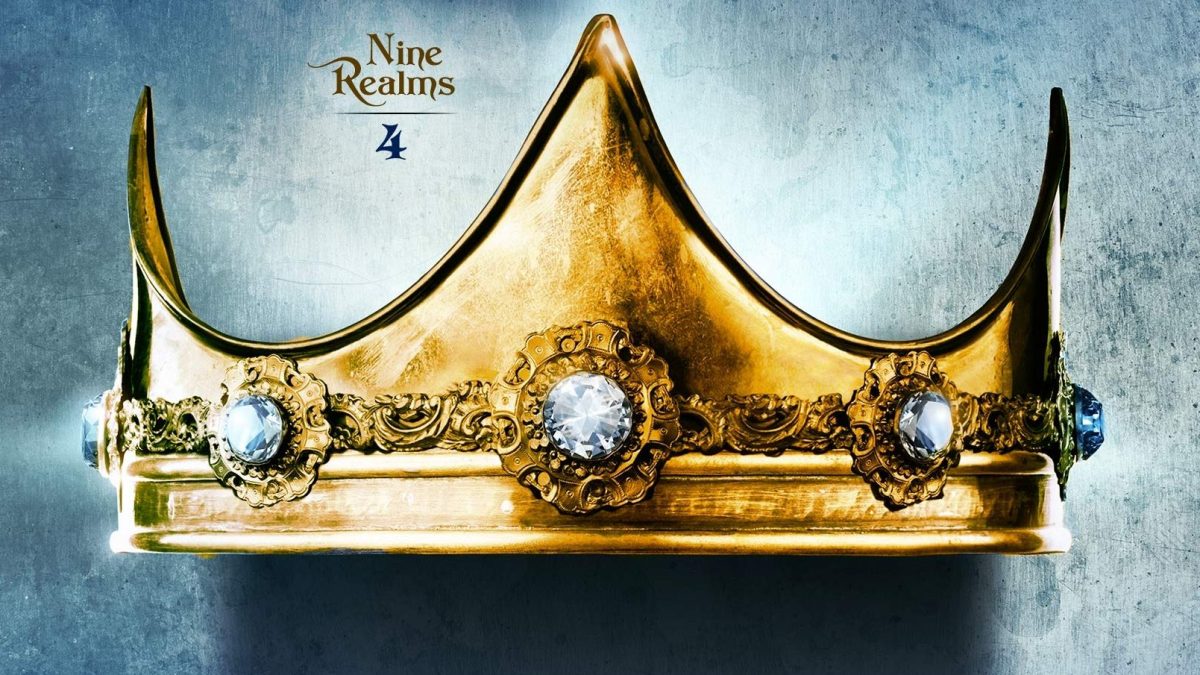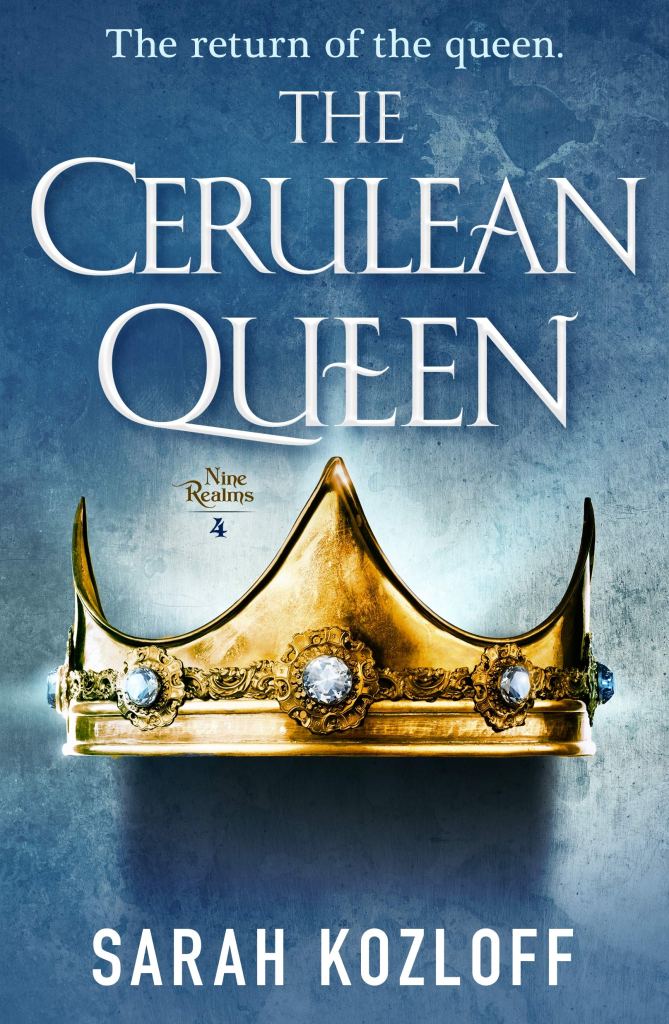The Cerulean Queen: The Many Lives of Fantasy Heroines
Let's talk about what Queen Cerúlia has in common with Arya Stark and Alanna of Trebond.

Warning: While this article doesn’t contain Cerulean Queen spoilers, it does discuss plot details from the first three books in the Nine Realms series: A Queen in Hiding, The Queen of Raiders, and A Broken Queen.
This post is sponsored by
Within the first fifty pages of Sarah Kozloff’s The Cerulean Queen, rightful heir Cerúlia has regained her lost throne and identified herself as Weirandale’s long-awaited queen—only for one of her subjects to immediately yell, “But yesterday, you was a village gal from Wyndton.” Another chimes in: “If you’re the queen, where have you been all these years?”
Never mind that Cerúlia has already answered this question, by admitting that she has spent the last thirteen years in hiding—as a humble farm girl, yes, but also as a soldier in scholar-turned-war-hero Thalen’s Raiders, and every working-class job in-between. Almost every person in her life knows her by a different name: Wren, Kestrel, Finch, Skylark—past lifetimes that she acknowledges as she prepares to take back the Nargis Throne: “Though I have gone by many names, I herewith claim back my true identity.”
Yet her triumphant moment of mythical destiny fulfillment is undercut by people who look at her—blue hair and magical Talent over animals notwithstanding—and do not see a queen. Not a queen by their standards, at least: a princella raised within the confines of her kingdom, trained and dressed by hundreds of years of royal etiquette and tradition, kept close at hand so that she only eats, sleeps, and breathes the experience of being a queen—nothing more, nothing less. A woman who simultaneously awaits the most incredible power, yet matures knowing no other potential future.
Instead, Cerúlia at the end of The Nine Realms series is the kind of multifaceted archetype who comes along all-too-rarely in epic fantasy: a woman who, despite having a clear destined role to fulfill, ironically cannot do so until she has led and discarded multiple lives separate than (and often contradictory from) the one she is ultimately meant to inhabit. This unusual queen is in good company, alongside fantasy heroines like Arya “A Girl Has No Name” Stark, caste-jumping merchant-artisan Rani Trader, and Alanna of Trebond, lady knight and The Woman Who Rides Like a Man. Truly, none of these classic characters would have had any hope of becoming legendary figures until they had walked a mile in a commoner’s shoes.
While hailing from a lesser-known series (Mindy L. Klasky’s The Glasswrights’ Apprentice and its sequels), Rani’s character arc hews the closest to Cerúlia’s, as she is forced to adopt multiple identities while fleeing a wrongful murder accusation. In the kingdom of Morenia, and especially its central City, a strict hierarchy keeps every citizen in their place with the command to “mind your caste”: Merchants are stuck scraping together humble livings, in contrast to the artisans who enjoy royal patronage as they pursue their specialized crafts, except in rare cases when merchant families can pay their children’s way into a new class, as was the case for Rani Trader to become apprentice Ranita Glasswright. Bracketing both ends of the class divide are the ruling family, with their extravagant five-syllable names, and the casteless, one-syllable-named Touched who roam the streets.
When Rani spots an assassin at the crowning of Prince Tuvashanoran, her attempt to warn him of the danger inadvertently causes the prince’s grisly murder. Further, it implicates both the glasswrights’ guild and her family, with both of the only worlds she’s ever known dishonored and razed to the ground. In desperation, Rani disappears into the City streets as Rai, a Touched girl. As she becomes embroiled in the very conspiracy that killed the crown prince, she adds and subtracts syllables to her name in order to inhabit different spheres within Morenia: Ranimara, a soldier’s sweetheart; Marita, a Pilgrim come to worship at the City who is selected to stay with the royal family; Ranikaleka, her older brother’s teasing endearment putting her on a royal pedestal even as Rani is forced to lie and murder in her hopes of clearing the Trader name.
Like Rani, Cerúlia is forced to change social station at a young enough age that she spends her adolescence more familiar with chaos than stability. The princella is eight years old when her mother, Queen Cressa the Enchanter, brings her to her new family. Facing war with the rival nation of Oromondo and fearing that the royal steward Lord Matwyck will attempt to rule through her daughter, Cressa places Cerúlia in the safest place she knows: with a humble village family she met by chance, but whose kindness made quite the first impression. After Stahlia and Wilim agree to take in young “Wren” as their own, Cressa enchants their memories so that there can be no chance of them unwittingly giving away the connection between their dark-haired (thanks to monthly dyeing) daughter and the blue-haired missing heir.
But Wren grows up in A Queen in Hiding with her memories intact, and all the pain that knowledge brings. “You must always know exactly who you are and where you come from,” Cressa implores her daughter in their final moments together. “You must always remember that your country lies in the hands of usurpers who wish us ill.” In contrast to other fantasy narratives where the farm boy (or girl) grows up oblivious to the vast political machinations playing out beyond their humble home, part of Wren’s birthright is knowing all of the sacrifices being made in her name, and the expectation that she someday make those lost lives worth something. She constructs an entire persona as Wren, down to the meek voice that makes others dismiss her, committing to the fiction per her mother’s orders: “Remember everything, but play your part all the time. […] The future of the Nargis Throne depends upon you staying safe and someday returning to Cascada.” In taking on that burden, Cerúlia risks alienating her foster mother Stahlia and adoptive sister Percia, who find themselves facing a stranger many times over in The Cerulean Queen.
“I don’t deserve a family,” Rani cries during an emotional breakdown late in The Glasswrights’ Apprentice. “I don’t deserve to belong to any group.” But the truth is, had Ranita never glimpsed the assassin lurking behind a stained-glass window, she would have continued existing in her own rarefied class, enjoying the king’s patronage but ignorant of the societal inequities suffered both by the Touched and by her own parents. By revealing how easy it is to infiltrate Morenia’s caste system, she helps to dismantle it from within.
Being a proper queen is not just having an awareness of class issues, however. It’s weighing the more ephemeral power of the crown and the sacrifices it demands, against the reality of fulfilling those royal orders. Cerúlia regains her throne through something of a coup involving the aid of the New Queen’s Shield—but she is able to ask others to raise swords for her only after wielding her own as part of Thalen’s Raiders. Despite the poetic name, this ragtag band of survivors are compelled by two things: their young leader, a scholar with the wit of a man twice his age; and their desire to confront the invading Oros. As Queen Cressa herself died in war, it makes sense that Kestrel, as the princella calls herself in The Queen of Raiders, seeks to retrace some of her mother’s legendary footsteps before embracing her birthright.
For Alanna of Trebond, Tamora Pierce’s iconic heroine, disguising herself as a boy when she herself is barely out of girlhood is the only way to have a future. As beloved as Pierce’s Tortall series is, it offers little to its female characters during Alanna’s youth; hiding as a boy allows her to flee a stultifying future as a wife and mother while gaining access to the privileges of knighthood. Of course, the bargain for any knights in training, but especially Alanna, is to learn to fight and to swear her sword in defense of the realm.
Alanna is able to keep her secret for only eight years, and honestly it’s partly due to divine intervention that she fools the necessary people for that long. While she undergoes her Ordeal of Knighthood and receives her shield as Sir Alan, a duel with her nemesis Duke Roger delivers the dual shock of Alanna being revealed as a woman… and killing Roger in self-defense. Despite Alanna’s wishes that people see her as the same person she always was, she knows that the realm needs time to reconcile these two people into one—so she does what any normal person would do in this case, which is run away.
In The Woman Who Rides Like a Man, Sir Alanna spends a year away from Tortall with the Bazhir, a desert tribe who are no less confused by her mix of masculine and feminine qualities, but who give her that title as a way of acknowledging her duality. Her time away from court also allows her to further embrace her magical Gift by teaching others to harness their own magic. Without this time away from the strictly male system of knighthood, Alanna would not have been able to return as the king’s Champion—nor would she have gotten to know herself well enough to determine how to become that honorable figure.
When asked if she’s running away from her temporary home to join Thalen’s Raiders, Kestrel admits that “this time I’d be running toward a duty I’ve put off.” Despite her fears that her birth family might have forgotten about her after over a dozen years in hiding, she is still reluctant to take the next step, knowing that she is putting her own destiny into motion.
By the time that she meets Commander Thalen in Oromondos, Cerúlia goes by Skylark, having decided on a new name for each land she passes through. Yet after more than half of her life shuffling personas like cards, the princella struggles to retain her sense of self: “It’s important to be recognized,” she thinks in a moment of crisis.
How many parts have I played? Chickadee, pampered heir to the throne, keeping my Talent hidden from my mother’s enemies. Low-class, orphaned Wren, pretending not to be quick in school, hiding in Percia’s shadow. Kestrel, confident boss of the carter’s yard. Finch, mysterious traveler, savior of refugees. Now, Skylark, vengeance-seeker from Sweetmeadow. I’ve become skilled at playacting, but I’m getting confused as to who I really am.
In fact, it’s her Talent that saves her—or rather, the fact that no matter how far from home she treks or which name she answers to, any and all creatures recognize her as Cerúlia. These moments of connection with horses and dogs and eagles reinforces her true identity as the princella, as the heir to the Nargis Throne.
Arya Stark does not have the same luxury of furry friends to keep her grounded. The fan favorite from George R.R. Martin’s A Song of Ice and Fire series (as well as HBO’s Game of Thrones) starts out already chafing against Westeros’ gender constraints, rejecting her sister Sansa’s affinity for embroidery and courtly intrigue in favor of sword-fighting, wishing for a warrior’s life instead of a wife’s.
She ultimately gets that wish, though at great cost, with her father Eddard’s execution propelling her out of the comfort of King’s Landing and into a myriad of different lives: Night’s Watch recruit, prisoner, and eventually assassin-in-training with the Faceless Men. As an acolyte within this guild, which serves the Many-Faced God of death, Arya more than any of these women learns what it means to wear many faces, both literally and figuratively. Because the only way for her to be able to adopt other visages for her kills is to erode her own identity—to scrape away Arya Stark until she is a blank slate, a girl with no name.
While it would appear that Arya masters this ability, to the point where she is welcomed into the Faceless Men, ultimately she rejects this absence of self in favor of re-embracing who she is: Arya Stark, who in place of a comforting menagerie to remind her of her identity instead possesses a list of people to kill.
As each of these women is in some way bound to a destiny, the inciting incident that sends each into hiding is mostly out of her control. Sometimes it’s divine, as with the Great Mother Goddess aiding her favored mortal Alanna, or the Thousand Gods manifesting themselves through Rai/Rani/Ranita/Ranimara/Marita. In other cases it’s human ugliness, like the game of thrones, that propels Arya into the life she once yearned for, and banishes Cerúlia from her childhood home.
But despite being forced to react to these changes in identity, every subsequent persona is a deliberate choice. Even if these women can visualize the people they’re supposed to be—lady knights, assassins, queens—they recognize that they are not ready to inhabit those roles yet. They need to grow and change into other people in-between.
There is a degree of fantasy wish fulfillment in this trope: Each of these women gets the opportunity to start over in a new life. We readers, retreating to these fantasy adventures as a break from our day jobs and personal obligations, do not have the luxury of trying on multiple personas and paths not taken. Yet we can live vicariously through these warriors and rulers who dye their hair or cut it off, who bind their breasts or slip on a new face, who moonlight as soldiers and shamans—all the while gaining valuable skills, trusted contacts, and life experience far beyond what they would have if they had taken the straight and narrow path.
At first it might seem anticlimactic that Cerúlia wrests back control of the Nargis Throne within just a few chapters of The Cerulean Queen—and especially considering that the last three tomes have been building to exactly this triumphant return. But therein lies Kozloff’s clever gambit: Claiming her identity was easy, just a matter of showing off her queenly blue locks and taming the official palace catamounts. Cerúlia’s true challenge, and the actual conflict that concludes the epic tale of The Nine Realms, lies in earning her place as queen in a way that none of her predecessors have: by being anything but.
The Cerulean Queen is now available to purchase. Check out the full synopsis below…
Sarah Kozloff’s breathtaking and cinematic epic fantasy series The Nine Realms, which began with A Queen in Hiding, comes to a thrilling conclusion in The Cerulean Queen.
The true queen of Weirandale has returned.
Cerulia has done the impossible and regained the throne. However, she’s inherited a council of traitors, a realm in chaos, and a war with Oromondo.
Now a master of her Gift, to return order to her kingdom she will use all she has learned—humility, leadership, compassion, selflessness, and the necessity of ruthlessness.

